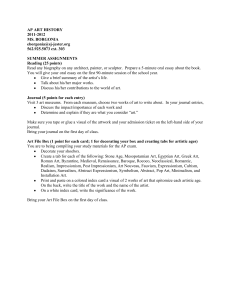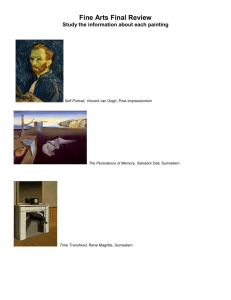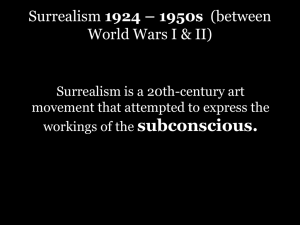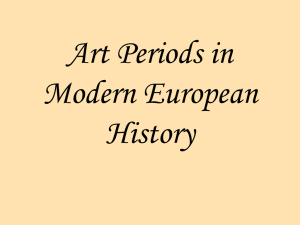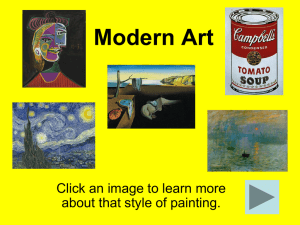File
advertisement
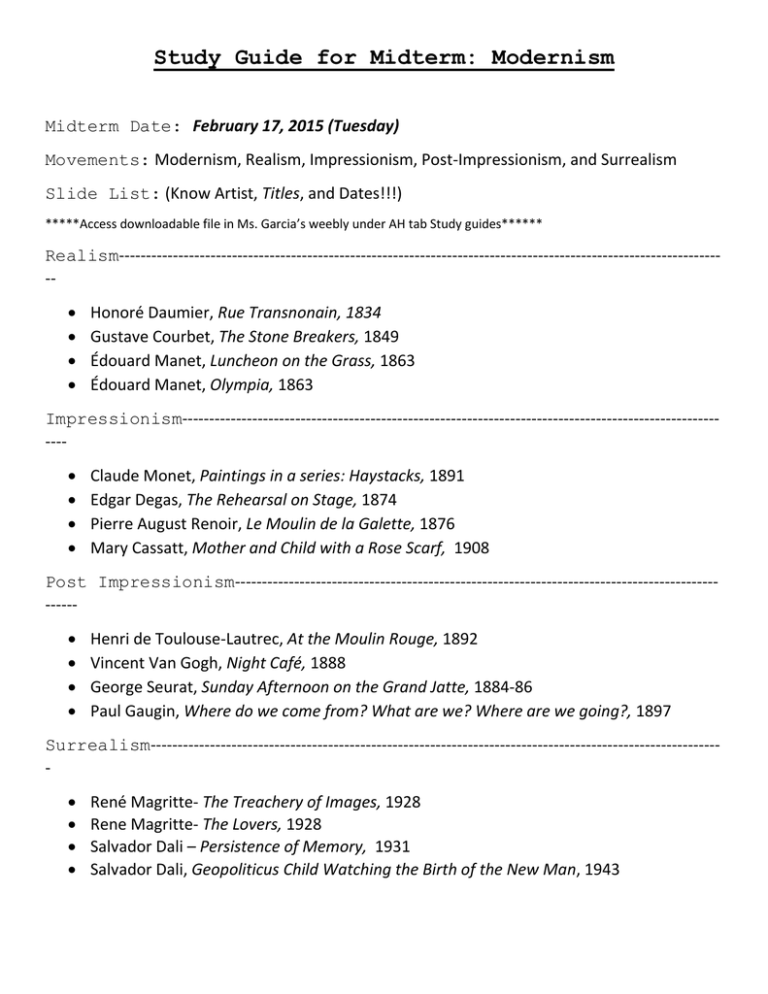
Study Guide for Midterm: Modernism Midterm Date: February 17, 2015 (Tuesday) Movements: Modernism, Realism, Impressionism, Post-Impressionism, and Surrealism Slide List: (Know Artist, Titles, and Dates!!!) *****Access downloadable file in Ms. Garcia’s weebly under AH tab Study guides****** Realism---------------------------------------------------------------------------------------------------------------- Honoré Daumier, Rue Transnonain, 1834 Gustave Courbet, The Stone Breakers, 1849 Édouard Manet, Luncheon on the Grass, 1863 Édouard Manet, Olympia, 1863 Impressionism------------------------------------------------------------------------------------------------------ Claude Monet, Paintings in a series: Haystacks, 1891 Edgar Degas, The Rehearsal on Stage, 1874 Pierre August Renoir, Le Moulin de la Galette, 1876 Mary Cassatt, Mother and Child with a Rose Scarf, 1908 Post Impressionism---------------------------------------------------------------------------------------------- Henri de Toulouse-Lautrec, At the Moulin Rouge, 1892 Vincent Van Gogh, Night Café, 1888 George Seurat, Sunday Afternoon on the Grand Jatte, 1884-86 Paul Gaugin, Where do we come from? What are we? Where are we going?, 1897 Surrealism--------------------------------------------------------------------------------------------------------- René Magritte- The Treachery of Images, 1928 Rene Magritte- The Lovers, 1928 Salvador Dali – Persistence of Memory, 1931 Salvador Dali, Geopoliticus Child Watching the Birth of the New Man, 1943 Vocabulary List:----------------------------------------------------------------------------------------------------1. Modernism-movement that began in the late 19th century (late 1800’s) in which artists rejected traditional ideas and favored current subject matter. 2. Positivism-Theory by Auguste Comte that expresses that all knowledge must come from proven ideas based on science or scientific theory 3. Lithograph-Printmaking technique for creating mass produced works of art. 4. Pointillism-a technique of painting small dots of color in applied patterns to form an image 5. Plein-air-painting outdoors to directly capture the effects of light and atmosphere 6. Subconscious Mind- the part of the mind that is not fully aware but influences one’s actions and feelings 7. Id- human animalistic tendencies (instincts, desires) 8. Ego- the realistic (reasonable) part of the subconscious that mediates between the desires of the ID and Super Ego. 9. Super Ego- The moral and critical part that stops you from doing certain things the ID may want you to do. 10.Collective Unconscious- how our mind collects and organizes personal experiences into representations that are recognizable to all members of the species. MODERNISM:------------------------------------------------------------------------------------------------------- What traditional ideas did Modernists reject? o Biblical/Religious Scenes o Aristocratic portraitures o Old myths and mythologies (gods/goddesses) Why did they reject these traditional ideologies? o Rise of technology, urbanization, and industrial revolution o New inventions: telephone, camera, car o New ideologies: Marx’ Socialism (social equality), Darwin’s human evolution o Know the Modernist mentality and reasons why they were devoted to representation of the physical world and not the metaphysical world. What type of artwork did the Modernists do? o Human daily lives: peasant life, oppression, prostitution, landscape/scenery, day to day life. REALISM:---------------------------------------------------------------------------------------------------------------- What are the characteristics of Realism? o Works of art that pertain to the real world o Lots of lower class subjects and narratives (workers, peasants, prostitutes, beggars) o These lower class subjects are shown in reverence (honest and sincere respect) o Dominant earthly colors (browns, greens, ochre, etc) Why were Realist so adamant about displaying only these subjects? IMPRESSIONISM:----------------------------------------------------------------------------------------------------- What are the characteristics of Impressionism? o Works of art that try to capture a fleeting moment o Technique includes significant amounts of color and brushstrokes o Painting is usually done in plein-air o Subject/Narrative ranges from still landscapes to human figures in movement and middle class urban life. o Impressionist mentality: Life is constantly changing and moving therefore the only thing that is “real” is the moment. How did the Impressionists differ from the Realists? What was the Impressionist mentality and what brought about this mentality? How did photography and the invention of the camera influence the Impressionists works of art? POST IMPRESSIONISM:--------------------------------------------------------------------------------------------- What was the Post-Impressionist mentality? o They did not like that Impressionism was all about color and light o Did not like that Impressionism became formal art (too mainstream) o They felt that Impressionism forgot to focus closely on formal artistic elements: line, color, pattern, and form. What was the style? o Subject/narrative was Parisian lifestyle of the middle class, French countryside, anything French related. o Very unstable emotional painters and all of their works are their own interpretations of reality. o Artists were regular drug and absinthe (hallucinogenic alcohol) users=influences their perception of reality. What was the “sickness” conveyed in most of the Post Impressionistic works of art? Why did they feel this way? Know a little of each artist’s life and mentality and how this is used to interpret their works of art. SURREALISM:---------------------------------------------------------------------------------------------------------- What are the characteristics of Surrealism? o Movement that began in the 1920’s created out of ideas that arose from Freud’s psychoanalysis and Carl Jung’s “collective unconscious” o Narrative/Subjects are open to interpretation many representing symbols, dreams, and the subconscious mind o Style varies from artist to artist making it very personalized (ex: Dali’s style) o Art that tries to represent the subconscious in the physical world. o MENTALITY: Surrealist artists believed “truth” was in the subconscious mind. How did Freud influence Surrealism? o Believed that everyone had a conscious and subconscious mind. o The subconscious mind was composed of three parts: Id, Ego, and Superego How did Jung influence Surrealism? o Believed in the “collective unconscious” that is part of the unconscious mind o What is an example of the collective unconscious? The “pyramid” is seen in so many cultures that had never been in contact before. These structures are prominent in human civilizations. Why are dreams and symbols so important to Surrealists such as Dali and Magritte? KNOW THE FOLLOWING FOR THE MIDTERM: 1. 2. 3. 4. 5. Know all artist names, titles, and dates (label or multiple choice) Know all the bullet points for each work of art (multiple choice or short answer) Know all the vocabulary words and definitions (multiple choice or matching) Know all the questions in bold (short answer or essay) Know the following art movements and their characteristics: Modernism (in general), Realism, Impressionism, Post Impressionism, and Surrealism. TIP: Study the Midterm Slide list (located in my weebly) for bullet point 1 and 2 Study this study guide for bullet points 3-5 Study your notes for the essay questions
